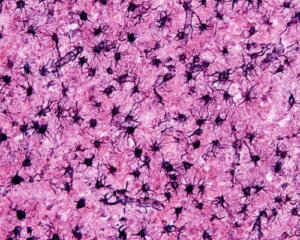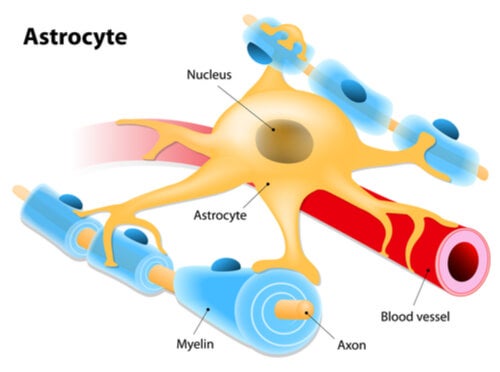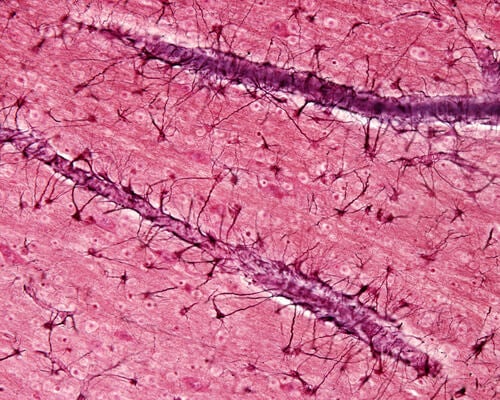Astrocytes: Builders of Nerve Pathways

Astrocytes, a type of brain cell, are the main components of a group of glial cells. Previously undervalued, today we know their importance.
Astrocytes form part of a group of glial cells. Their importance has been questioned across time. At first, experts underestimated their function, since their complete relevance was to transport the neurons. However, it’s been shown that they don’t just complete a passive function and their work isn’t only to complement neurons.
In fact, these types of glial cells are in charge of constructing nerve pathways and other functions such as:
- Guiding neurons during migration.
- Causing the formation of the hematoencephalic level.
- The metabolic support of the neurons.
- Collaboration in neuron generation.
As you can see, there’s a lot to learn and know about astrocytes. For instance, it’s surprising how they respond to neural activity, how they repair themselves, and the communication they possess. Let’s delve deeper into this.

Types of astrocytes
Astrocytes completely surround the cerebral capillaries and form a physical barrier between the blood and the neurons. They contain diverse typologies that generate different varieties.
- Protoplasmatic astrocytes. Located in the gray matter. They’re the shape of a sphere with offshoots that extend to other branches that are irregular and curved. The outer branches cover the blood vessels, the meninges surface, and the synapses.
- Fibrous astrocytes. Located in the white matter. They’re long and thin and without branches, in the shape of fibers. Their ends wrap around the Ranvier nodes of the axons and the blood vessels.
As a curiosity, the ends of the astrocytes that form these cells are similar to the shape of a star. They’re extensions that go over the neighboring cells.
In addition, astrocytes have a protein called glial fibrillary acidic protein in the cytoskeleton. Namely, this is the characteristic that makes them different, since they’re only in this type of cell.
Functions
Astrocytes construct the pathways for the transmission of information in your brain. Thanks to the neural connections that they deliver, they’re in charge of helping guide the way that carry out the axons. This is accomplished through the molecules that attract or repel.
As good builders, the astrocytes are aware of what’s going on in the nervous system. Because of that, they take on the task of the equilibrium of neurons or cerebral homeostasis. Due to this function, they act as metabolic support, which is achieved through the conservation of ionic balance of the nerve cells.
Besides carrying out all of the above-mentioned tasks, astrocytes participate in the maturation, and in the maintenance of synopsis neurons. In addition, they provide oxygen, nutrients, and protective insulation to the neurons.
However, by means of a process known as phagocytosis, these cells are able to eliminate residues from the cerebral metabolism. As a result, this process is beneficial since it allows the disposal of wastes and pathogens. Also, they can be eliminated by transporting the residues to the blood. Moreover, when a stroke occurs, the astrocytes travel to the lesion to get rid of the dead neurons.
On the other hand, they form part of the very important hematoencephalic barrier, which converts them into intermediaries between the circulatory system and the neurons as a filtering mechanism. Therefore, they’re also in charge of regulating the path of molecules from the blood to the brain.
Astrocytes are linked to the neurotransmitters since they respond to them in an active manner and have receptors that combine with them. This is a real method of communication of this type of glial cells that are complemented with another way of sending messages to isolate the space in the synaptic junctions and act as signal modulators between neurons.
Astrocytes and reactive gliosis
There’s a pathological process that increases the rapid and inordinate number of astrocytes. This process accompanies the inflammatory phenomena and is called reactive gliosis.
Scientists have found two types of astrocytes when there’s this type of proliferation: the A2, which has repairing functions, and the A1, which causes the degradation of nerve tissue.
Reactive gliosis occurs when there’s a lesion in the nervous system. Then it’s accompanied by a proliferation of these cells in the regions that the damage takes place. In fact, many studies have demonstrated this phenomenon.

What facilitates this and what doesn’t?
The reactive gliosis is beneficial because it creates a synthesis of neurotrophic factors that are in charge of the survival of the neurons. On the other hand, it’s harmful because it creates a glial scar that makes a barrier for axon growth.
This phenomenon is vital in clinical studies since it gives hope for new therapeutic models. For example, experts study stem cell transplants using neurotrophic factors that promote neural regeneration. In fact, there are studies for finding cures for neurodegenerative diseases such as Alzheimer’s and Parkinson’s disease.
What makes them great builders of the nervous system?
Astrocytes are in charge of establishing points of communication between distinct cells and the nervous system. Besides, given that they’re responsible for isolating and eliminating harmful substances, they fight against brain injuries. They also allow for the reestablishment of these communication paths.
Astrocytes are prepared to create links between various areas and anatomical-functional elements. For instance, these would be the circulatory system, and the hematoencephalic barrier, between the neurons themselves, and with the cerebral neurotransmitters. In addition, they’re exceptional when it comes to maintaining nerve pathways. This is because they make the nervous system maintain its internal equilibrium.
From all of these findings, our hope is that neuroscience continues to study these cells and their potential applications. This will pave the way to new advances related to these types of glial cells.
Astrocytes, a type of brain cell, are the main components of a group of glial cells. Previously undervalued, today we know their importance.
Astrocytes form part of a group of glial cells. Their importance has been questioned across time. At first, experts underestimated their function, since their complete relevance was to transport the neurons. However, it’s been shown that they don’t just complete a passive function and their work isn’t only to complement neurons.
In fact, these types of glial cells are in charge of constructing nerve pathways and other functions such as:
- Guiding neurons during migration.
- Causing the formation of the hematoencephalic level.
- The metabolic support of the neurons.
- Collaboration in neuron generation.
As you can see, there’s a lot to learn and know about astrocytes. For instance, it’s surprising how they respond to neural activity, how they repair themselves, and the communication they possess. Let’s delve deeper into this.

Types of astrocytes
Astrocytes completely surround the cerebral capillaries and form a physical barrier between the blood and the neurons. They contain diverse typologies that generate different varieties.
- Protoplasmatic astrocytes. Located in the gray matter. They’re the shape of a sphere with offshoots that extend to other branches that are irregular and curved. The outer branches cover the blood vessels, the meninges surface, and the synapses.
- Fibrous astrocytes. Located in the white matter. They’re long and thin and without branches, in the shape of fibers. Their ends wrap around the Ranvier nodes of the axons and the blood vessels.
As a curiosity, the ends of the astrocytes that form these cells are similar to the shape of a star. They’re extensions that go over the neighboring cells.
In addition, astrocytes have a protein called glial fibrillary acidic protein in the cytoskeleton. Namely, this is the characteristic that makes them different, since they’re only in this type of cell.
Functions
Astrocytes construct the pathways for the transmission of information in your brain. Thanks to the neural connections that they deliver, they’re in charge of helping guide the way that carry out the axons. This is accomplished through the molecules that attract or repel.
As good builders, the astrocytes are aware of what’s going on in the nervous system. Because of that, they take on the task of the equilibrium of neurons or cerebral homeostasis. Due to this function, they act as metabolic support, which is achieved through the conservation of ionic balance of the nerve cells.
Besides carrying out all of the above-mentioned tasks, astrocytes participate in the maturation, and in the maintenance of synopsis neurons. In addition, they provide oxygen, nutrients, and protective insulation to the neurons.
However, by means of a process known as phagocytosis, these cells are able to eliminate residues from the cerebral metabolism. As a result, this process is beneficial since it allows the disposal of wastes and pathogens. Also, they can be eliminated by transporting the residues to the blood. Moreover, when a stroke occurs, the astrocytes travel to the lesion to get rid of the dead neurons.
On the other hand, they form part of the very important hematoencephalic barrier, which converts them into intermediaries between the circulatory system and the neurons as a filtering mechanism. Therefore, they’re also in charge of regulating the path of molecules from the blood to the brain.
Astrocytes are linked to the neurotransmitters since they respond to them in an active manner and have receptors that combine with them. This is a real method of communication of this type of glial cells that are complemented with another way of sending messages to isolate the space in the synaptic junctions and act as signal modulators between neurons.
Astrocytes and reactive gliosis
There’s a pathological process that increases the rapid and inordinate number of astrocytes. This process accompanies the inflammatory phenomena and is called reactive gliosis.
Scientists have found two types of astrocytes when there’s this type of proliferation: the A2, which has repairing functions, and the A1, which causes the degradation of nerve tissue.
Reactive gliosis occurs when there’s a lesion in the nervous system. Then it’s accompanied by a proliferation of these cells in the regions that the damage takes place. In fact, many studies have demonstrated this phenomenon.

What facilitates this and what doesn’t?
The reactive gliosis is beneficial because it creates a synthesis of neurotrophic factors that are in charge of the survival of the neurons. On the other hand, it’s harmful because it creates a glial scar that makes a barrier for axon growth.
This phenomenon is vital in clinical studies since it gives hope for new therapeutic models. For example, experts study stem cell transplants using neurotrophic factors that promote neural regeneration. In fact, there are studies for finding cures for neurodegenerative diseases such as Alzheimer’s and Parkinson’s disease.
What makes them great builders of the nervous system?
Astrocytes are in charge of establishing points of communication between distinct cells and the nervous system. Besides, given that they’re responsible for isolating and eliminating harmful substances, they fight against brain injuries. They also allow for the reestablishment of these communication paths.
Astrocytes are prepared to create links between various areas and anatomical-functional elements. For instance, these would be the circulatory system, and the hematoencephalic barrier, between the neurons themselves, and with the cerebral neurotransmitters. In addition, they’re exceptional when it comes to maintaining nerve pathways. This is because they make the nervous system maintain its internal equilibrium.
From all of these findings, our hope is that neuroscience continues to study these cells and their potential applications. This will pave the way to new advances related to these types of glial cells.
All cited sources were thoroughly reviewed by our team to ensure their quality, reliability, currency, and validity. The bibliography of this article was considered reliable and of academic or scientific accuracy.
- Nedergaard, M., Ransom, B, & Goldman, S. (2003) New roles for astrocytes: Redefining the functional architecture of the brain. Trends in neurosciences, 26(10), 523-530.
This text is provided for informational purposes only and does not replace consultation with a professional. If in doubt, consult your specialist.







